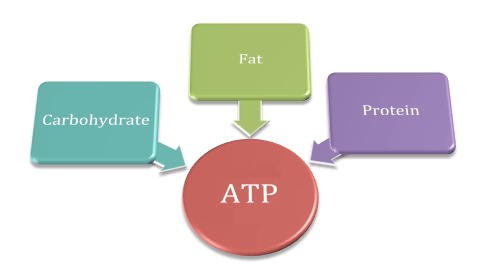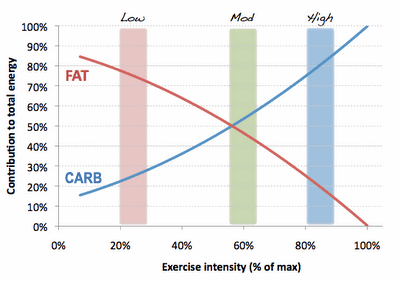In our last article we looked briefly at the three energy pathways taking place within our bodies. Carbohydrates, protein, and fat enter an energy pathway to become adenosine triphosphate (ATP) which powers muscle contraction. We saw that ATP is produced either with or without oxygen (aerobic and anaerobic respectively).
In addition, we also discussed that the dominant energy pathway involved in an activity is generally related to the time, intensity and sustainability of the activity. Short duration and higher intensity activities that cannot be maintained beyond a couple minutes are more anaerobic, while lower intensity activities that can be sustained over long periods of time are more aerobic.
Fueling the Energy Systems
One of the key differences between aerobic and anaerobic metabolism, other than whether or not oxygen is used, is the nutrient that is the precursor to ATP production. Aerobic metabolism can use fat and carbohydrates, as well as protein, to produce ATP. Fat and carbohydrates are the body’s preferred sources, with protein much less so. Anaerobic glycolytic metabolism, on the other hand, uses only carbohydrate to produce ATP.
The “Fat Burning Zone” Myth
In fact, the lower the intensity involved for a given activity, the greater the percentage of fat that your body uses as its primary fuel source. This fact is what is behind the myth of the “fat burning zone” and is cause for many people wasting countless hours on the treadmill.
It is true that a greater percentage of fat is used for energy at lower intensities. However, the total number of calories consumed at lower intensities hardly makes it worthwhile. Factor in that you quickly adapt to these low intensities, and that you’ll be burning lesser amounts of fat to do the same work, and you’ll discover why so often “aerobics” is an extremely inefficient means of losing weight. It has its place, but if time is a concern, you can do better.
Kicking It Up
As the intensity of an activity increases, the metabolism of carbohydrates increases as well. As an anaerobic energy pathway, glycolysis uses only carbohydrates to create ATP. The thing is, your body only stores enough carbohydrates to sustain a few hours of moderate to high level activity. Whereas, you generally have enough fat to fuel activity for many hours and even days as long as there is enough oxygen present.
So, as you raise the level of intensity of activity, you’re burning more carbs versus fat percentagewise, however you are burning more calories overall. Quite possibly you are burning more fat calories as well. The thing is, high intensity activity can’t be maintained very long. The answer is high intensity interval training.
Is It HIIT or a Metabolic Workout?
While no standard definition exists for HIIT, many define it in the context of a “cardio” workout. Generally people imagine cardio as a treadmill, elliptical, or other movement or device, used to perform aerobic activities of varying intensities. The truth is all exercise places demands on the cardiovascular system. Therefore, nearly any type of exercise can be used for HIIT.
Obviously HIIT incorporates intervals of some sort and to qualify they need to be performed with intensity. That intensity relates to some sort of extreme degree, incorporating speed, strength, power, or force, and more like it, a combination of these. The intervals involve varying time factors of work and rest with the emphasis on performing increasingly greater amounts of work and minimizing, but not eliminating, rest periods.
A Metabolic Workout refers to training of the energy systems pathways which we have just discussed. HIIT, done properly, is Metabolic Workout. The high intensity requires going beyond the aerobic pathways and working out anaerobically. Minimizing rest intervals prevent the workout from being a pure anaerobic workout.
Whether you call it HIIT, or a Metabolic Workout, when it is performed properly it will take you out of your comfort zone and leave you breathless!
Next time we will discuss how a Metabolic Workout elevates your metabolism, burns fat, builds muscle, and creates other “metabolic disturbances: in your body. Stay tuned…


{ 2 comments… read them below or add one }
I wanted to thank you yet again for this amazing web-site you have designed here. It’s full of ideas for those who are definitely interested in this subject, especially this very post. You’re really all absolutely sweet and thoughtful of others plus reading your blog posts is a superb delight if you ask me. And what a generous gift! Ben and I are going to have fun making use of your points in what we should instead do next week. Our list is a mile long and tips might be put to good use.
My website is on Depression and anxiety.
Thank you for the kind words! And the outbounds help my rankings as well
You must log in to post a comment.